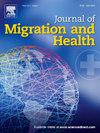Emptying villages, overflowing glasses: Out-migration and drinking patterns in Rural China
IF 2.9
Q1 PUBLIC, ENVIRONMENTAL & OCCUPATIONAL HEALTH
引用次数: 0
Abstract
Background
Rural-urban migration is a significant phenomenon in China, resulting in family separation and the emergence of left-behind populations in rural communities. Previous research suggests that migration can influence health behaviors through various pathways. However, limited empirical studies have examined the effects of migration on the drinking behavior of adults left behind. Moreover, the impact of migration at the household and community levels remains unclear.
Methods
This study analyzes the relationship between migration and drinking behavior in rural China with data from the China Health and Nutrition Survey (CHNS 1997–2015) (N = 20,264). Multilevel mixed-effects models are employed to test how household and community levels migration status affects rural residents' weekly alcohol intake.
Results
Weekly alcohol intake would increase by 7.51 g (SE = 2.976, p = 0.012) for men and 0.98 g (SE = 0.419, p = 0.019) for women in families whose members have moved out, while the influence of household migration was no longer significant after controlling for community-level effects. One percentage change in community migration rates would increase men's alcohol intake by 0.6319 g (SE = 26.494, p = 0.017) and women's by 0.0823 g (SE = 2.394, p = 0.001).
Conclusions
Our study emphasizes the importance of considering migration at different levels of analysis. The findings indicate that out-migration is associated with increased alcohol consumption among left-behind adults in rural China. Intervention policies should also consider the unique neighborhood relations in rural China, potentially leveraging social ties within rural communities to spread health awareness and reduce alcohol consumption.
村庄空了,杯子满了:中国农村的外迁和饮酒模式
农村向城市迁移是中国的一个重要现象,它导致了家庭分离和农村社区留守人口的出现。先前的研究表明,移民可以通过各种途径影响健康行为。然而,有限的实证研究调查了移民对留守成年人饮酒行为的影响。此外,移徙对家庭和社区的影响仍不清楚。方法利用中国健康与营养调查(CHNS 1997-2015) (N = 20,264)的数据,分析中国农村人口迁移与饮酒行为的关系。采用多水平混合效应模型检验家庭和社区水平移民身份对农村居民每周酒精摄入量的影响。结果迁出家庭中男性每周酒精摄入量增加7.51 g (SE = 2.976, p = 0.012),女性每周酒精摄入量增加0.98 g (SE = 0.419, p = 0.019),在控制了社区水平的影响后,家庭迁出的影响不再显著。社区迁移率每变化一个百分点,男性酒精摄入量将增加0.6319 g (SE = 26.494, p = 0.017),女性酒精摄入量将增加0.0823 g (SE = 2.394, p = 0.001)。结论我们的研究强调了在不同层次分析中考虑迁移的重要性。研究结果表明,外迁与中国农村留守成年人饮酒增加有关。干预政策还应考虑中国农村独特的邻里关系,潜在地利用农村社区内的社会关系来传播健康意识和减少酒精消费。
本文章由计算机程序翻译,如有差异,请以英文原文为准。
求助全文
约1分钟内获得全文
求助全文
来源期刊

Journal of Migration and Health
Social Sciences-Sociology and Political Science
CiteScore
5.70
自引率
8.70%
发文量
65
审稿时长
153 days
 求助内容:
求助内容: 应助结果提醒方式:
应助结果提醒方式:


